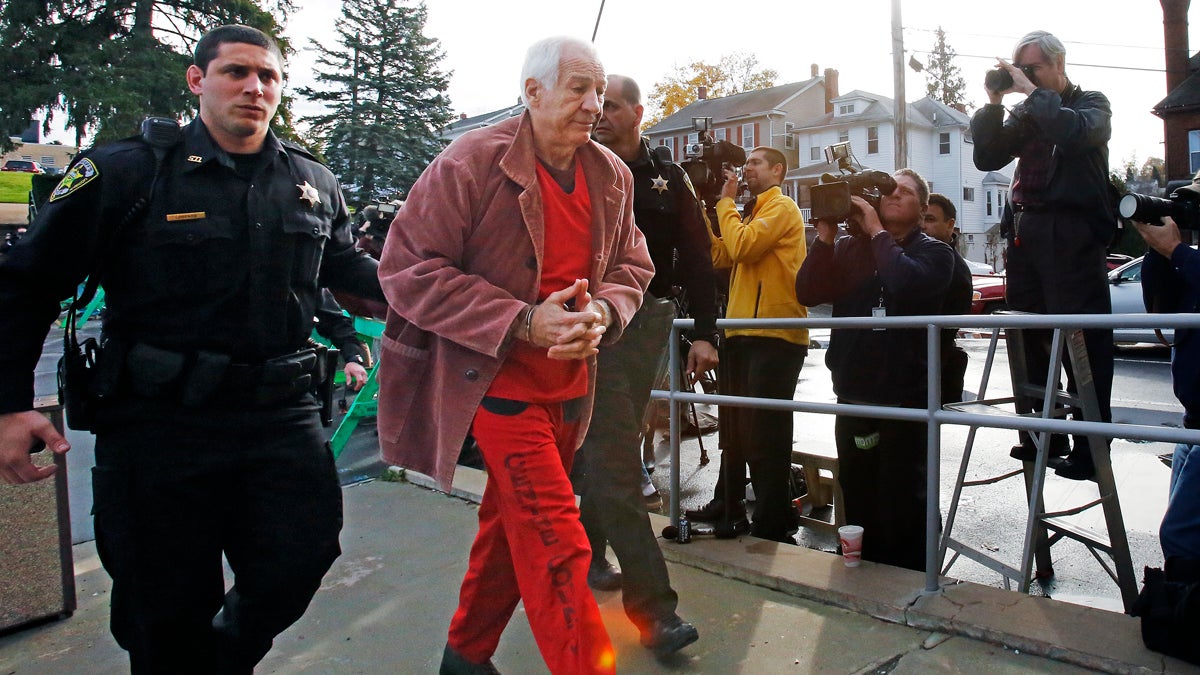Proactive child abuse prevention gets increased attention as fatality rate rises in Pa.

Former Penn State University assistant football coach Jerry Sandusky arrives at the Centre County Courthouse for a hearing about his appeal on his child sex-abuse conviction in Bellefonte, Pa., Oct. 29, 2015. (Gene J. Puskar/AP Photo)
Lawmakers and law enforcement groups are asking for $9 million for home visit programs.
Summer Chambers, a chubby cheeked five-month-old died of starvation and dehydration in her crib, four days after her parents died from drug overdoses in Johnstown, Pennsylvania.
Zyair Worrell, a two-year-old boy in Philadelphia, was killed by his mother’s boyfriend. He was found unresponsive with lacerations, abrasions, bruising and THC in his system.
Isabel Rose Godfrey, a three-year-old, showing off a toothy smile in a photo submitted to the York Daily Record, was killed by her mother who was likely on drugs. Police were notified after Godfrey’s six-year-old brother ran into the neighbor’s house yelling that his mother was trying to kill his sister.
These are just three of the 46 children who died in 2016 from child abuse.
In addition, there were 79 near-fatalities, where the child would have died without medical intervention. Both numbers represent a significant increase from the year before and the highest number in at least five years. (There were 36 fatalities and 57 near fatalities in 2015.)
The sharp increase in child abuse-related fatalities has drawn the attention of the Auditor General, who has promised a special report on the state’s child welfare system, and Governor Tom Wolf, who has allocated more funding for child and youth agencies in his upcoming budget.
Now, lawmakers and law enforcement agencies are calling for an additional approach: funding home-visit programs that proactively reduce the risk of child abuse — before it occurs.
‘Lopsided’ funding
Currently, Pennsylvania funds child abuse prevention through the 67 county-level child and youth agencies. Those agencies have been struggling since 2014 when the legislature passed 24 new laws aimed at preventing another Jerry Sandusky sex abuse scandal.
Those laws widened the definition of child abuse, increased the number of mandatory reporters, and created strict penalties for not reporting suspected abuse. But these changes didn’t come with any additional funding for agencies charged with responding to and investigating these claims.
This year’s proposed budget increases that funding, which will alleviate some of the burden on these county agencies. But while those agencies are getting funded and functioning again, advocates say it’s also time to think about the other end of the equation.
“Our funding is and always has been so lopsided towards being reactive,” said Cathy Palm, founder of Center for Children’s Justice. “At some point, we have to shift the paradigm from thinking we’ll just intervene when something has already happened to a child to thinking, we know what stressors can cause something like this to happen. How can we prevent that from happening?”
Home visit programs
The $9 million lawmakers are requesting for child abuse prevention would go towards funding four home visit programs: the Nurse-Family Partnership, Parents as Teachers, Healthy Families America, and Early Head Start.
These programs help parents help their children, often beginning with pregnant mothers. Paraprofessionals, social workers, nurses and child care professionals visit families in their homes to offer support, teach parenting skills, encourage child development and help parents access services. There is significant evidence that, implemented correctly, home visit programs improve child outcomes, and in some cases, can reduce the risk of child abuse.
“A lot of people like to think of abuse as coming from evil people,” said Palm. “We try to remind people that so often, children are harmed because there’s this cascade of stressors. Maybe there’s job loss, house loss, intimate partner violence and it becomes too much. That’s when parents lose their temper and a child gets hurt.”
Home visit programs help parents, particularly young parents, develop coping skills and positive parenting techniques. The programs also help children by offering early learning and development opportunities in the home.
“You have to build up and support, in any way you can, parents, because the very best first step in preventing child abuse is having strong healthy parents who understand child development and positive parenting,” said Angela Liddle, president and CEO of the Pennsylvania Family Support Alliance.
The other “H” in the room
The three child deaths mentioned at the beginning of this story have another common thread: substance abuse. The opioid and heroin epidemic has severely taxed the child welfare system, and advocates say everyone has been slow to admit that.
“Standing next to that person who overdosed is a kid, picking up the phone and calling 911 to report an overdose is often a kid, sitting in the backseat of the car where a parent has overdosed is a child,” said Palm. “We just really haven’t come to grips with that reality.”
The heroin and opioid epidemic has burdened Pennsylvania’s child welfare system when it is already struggling with unfunded mandates from the legislature. Liddle says there is no way these factors haven’t contributed to the rise in child fatalities in Pennsylvania.
Both Palm and Liddle agree that home visit programs are one part of the answer. These programs don’t alleviate poverty or prevent substance abuse outright. But they can help parents manage the different issues that lead to abuse and can help keep the right people in the loop.
“When children die in Pennsylvania, a lot of times, these are families that were on someones radar,” said Palm. “We know they’re under stress, but we don’t connect them to proven services that potentially help to mitigate or resolve that stress. Then we all act a little surprised and outraged when something bad happens to that child. But we knew.”
WHYY is your source for fact-based, in-depth journalism and information. As a nonprofit organization, we rely on financial support from readers like you. Please give today.


